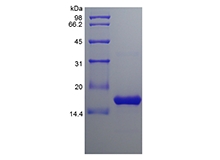| Official Full Name |
Recombinant Human B cell Activating Factor/TNFSF13B (rHuBAFF/TNFSF13B) |
| Squence |
 |
| Amino Acid Sequence |
MAVQGPEETV TQDCLQLIAD SETPTIQKGS YTFVPWLLSF KRGSALEEKE NKILVKETGY FFIYGQVLYT DKTYAMGHLI QRKKVHVFGD ELSLVTLFRC IQNMPETLPN NSCYSAGIAK LEEGDELQLA IPRENAQISL DGDVTFFGAL KLL |
| Synonyms |
TNFSF13B, TNFSF20, TALL-1, BLys, THANK, B cell Activating Factor belonging to the TNF family |
| Accession Number |
Q9Y275 |
| GeneID |
10673 |
| Summary |
B-cell activating factor (BAFF), also known as Blys, TALL-1, TNAK, and zTNF4, is a TNF ligand superfamily member and has been designated TNFSF13B. Produced by macrophages, dendritic cells, and T lymphocytes, BAFF promotes the survival of B cells and is essential for B cell maturation. BAFF binds to three TNF receptor superfamily members: B-cell maturation antigen (BCMA/TNFRSF17), transmembrane activator and calcium-modulator and cyclophilin ligand interactor (TACI/TNFRSF13B) and BAFF receptor (BAFF R/BR3/TNFRSF 13C). These receptors are type III transmembrane proteins that lack a signal peptide. Whereas TACI and BCMA bind BAFF and another TNF superfamily ligand, APRIL (a proliferation-inducing ligand), BAFF R selectively binds BAFF. The BAFF R extracellular domain lacks the TNF receptor canonical cysteine-rich domain (CRD) and contains only a partial CRD with four cysteine residues. Human and mouse BAFF R share 56 % a.a. sequence identity. BAFF R is highly expressed in spleen, lymph node and resting B cells. It is also expressed at lower levels in activated B cell, in resting CD4+ T cells, in thymus and peripheral blood leukocytes. |
| Source |
Escherichia coli. |
| Molecular Weight |
Approximately 17.2 kDa, a single non-glycosylated polypeptide chain containing 153 amino acids. |
| Biological Activity |
Fully biologically active when compared to standard. The ED50 as determined by a mouse splenocyte survival assay is 0.5-2 ug/ml. |
| Appearance |
Sterile filtered white lyophilized (freeze-dried) powder. |
| Formulation |
Lyophilized from a 0.2 um filtered concentrated solution in PBS, pH 7.0. |
| Endotoxin |
Less than 1 EU/ug of rHuBAFF as determined by LAL method. |
| Reconstitution |
We recommend that this vial be briefly centrifuged prior to opening to bring the contents to the bottom. Reconstitute in sterile distilled water or aqueous buffer containing 0.1 % BSA to a concentration of 0.1-1.0 mg/mL. Stock solutions should be apportioned into working aliquots and stored at ≤ -20 °C. Further dilutions should be made in appropriate buffered solutions. |
| Stability and Storage |
Use a manual defrost freezer and avoid repeated freeze-thaw cycles.- 12 months from date of receipt, -20 to -70 °C as supplied.- 1 month, 2 to 8 °C under sterile conditions after reconstitution.- 3 months, -20 to -70 °C under sterile conditions after reconstitution. |
| References |
|
| SDS-PAGE |
 |
| Safety Data Sheet (SDS) Download |
Click to download |
| Technical Data Sheet (TDS) Download |
Click to download |



